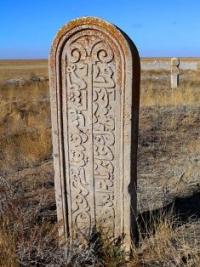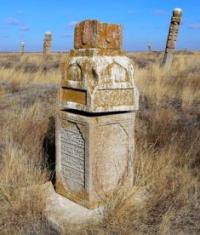You are here
Necropolis Abat-Baitak.


Guide to Hiking in Aktobe region.
"First of all, it should be remembered that, without accurate data on the nature of the material from which the object is built, without knowing its properties and the technique of its processing, it is generally impossible to undertake restoration..."
M.V. Farmakovsky.
Tourist infrastructure of Kazakhstan.
The necropolis of Abat-Baitak (Baytakmola) is located 872 meters east of the drying out bed of the Batpakty brook, 18 kilometers south-east of the regional center Kobda, 12.7 kilometers south and slightly west of the Taldysai village in the Khobdinsky district of the Aktobe region.
On the necropolis, to the west of the mausoleum Abat-Baitak, there is a late necropolis (XVIII - early XX centuries). The ensemble of magnificent carved steles of kulpytas, of which there are more than 200, are located on the Abat-Baitak necropolis, located on the western side of the grave mounds or adobe fences.
Kulpytases of various elaboration and compositional solutions were mainly placed on the western side of an earthen embankment, rock fill or a fence. The uniqueness of the necropolis lies in the fact that no one kulpytas is like another.
Kulpytasy Abat-Baitak is a special phenomenon in the West Kazakhstan stone-cutting art. They are very diverse, distinguished by the originality of the architectural, spatial and artistic solution. Among them, there are both early epigraphic varieties and later types of volumetric structure.
For most of the stelae of the XIX century. the combination of epigraphy and decor is characteristic, which prevails, which allows them to be considered as monuments of glyptics. Based on this, a group of monuments of the stone-cutting school of the mid-XIXth century with the finest elaboration of details can be distinguished.
Often the volumetric decorative elements of kulpytas are made in the tradition of wood carving with the predominant use of plant motifs. In general, the kulpytases of the Abat-Baitak necropolis are executed in the spirit of the common for Western Kazakhstan tradition of the development of art steles, but with an emphasis on the local school of glyptics (complex volumetric-spatial composition, variety of carving techniques, richness of decor, plant motifs).
The cemetery has a stele made of petrified wood, flat simple kulpytases, volumetric steles with high carving technique, monuments in the form of a pedestal, etc. In addition to carving, with a display of plant and geometric ornaments, weapons and women's jewelry were sometimes depicted on the steles.
In most cases, an epitaph was knocked out from the western side, containing the Koranic text and information about the deceased. Tamgas of Kazakh clans are knocked out on many kulpytas: tabyn, kete, alshyn, baibakty, shekty, etc.
These design elements can also be traced in small ancestral cemeteries of the late XIXth - early XXth centuries, located in the valley of the Uly-Khobda River (cemeteries in the Tompak-mosque area, etc.)
Geographic coordinates of the Abat-Baytak necropolis: N50 ° 05'45.30 "E55 ° 54'24.73"
Authority:
“The architecture of the Aral-Caspian Sea: area, chronology, traditions”. Alexander Petrov.
Photos by
Alexander Petrov.







